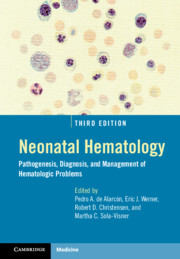Book contents
- Neonatal Hematology
- Neonatal Hematology
- Copyright page
- Contents
- Foreword
- Preface
- Contributors
- Section I Developmental Hematology
- Section II Bone Marrow Failure and Immune Disorders
- Section III Erythrocyte Disorders
- Section IV Platelet Disorders
- Section V Leucocyte Disorders
- Section VI Hemostatic Disorders
- Section VII Neonatal Transfusion Medicine
- Section VIII Neonatal Oncology
- Section IX Miscellaneous
- Index
- Plate Section (PDF Only)
- References
Section VII - Neonatal Transfusion Medicine
Published online by Cambridge University Press: 30 January 2021
- Neonatal Hematology
- Neonatal Hematology
- Copyright page
- Contents
- Foreword
- Preface
- Contributors
- Section I Developmental Hematology
- Section II Bone Marrow Failure and Immune Disorders
- Section III Erythrocyte Disorders
- Section IV Platelet Disorders
- Section V Leucocyte Disorders
- Section VI Hemostatic Disorders
- Section VII Neonatal Transfusion Medicine
- Section VIII Neonatal Oncology
- Section IX Miscellaneous
- Index
- Plate Section (PDF Only)
- References
Summary
Neonatal transfusion therapy requires an understanding of the dynamic interactions of the fetomaternal unit, the physiologic changes that accompany the transition from fetus to neonate to infant, and the underlying pathophysiology of different hematologic disorders. Guidelines for neonatal transfusions remain controversial, since most have been extrapolated from evidence in adults or based on small studies in neonates with marginal statistical validity. Compared to older children and adults, neonates have small total blood volumes but high blood volume per body weight. Because of the limited capacity to expand their blood volume to compensate for their rapid growth, many sick and/or premature infants require significant blood component support, especially within the first weeks of life. Immaturity of many organ systems predisposes them to metabolic derangements from blood products and their additive solutions, and to the infectious and immunomodulatory hazards of transfusion, such as transfusion-acquired CMV (TA-CMV) infection and transfusion-associated graft versus host disease (TA-GVHD). Therefore, component modifications are often required to compensate for the infant’s small blood volume, immunologic immaturity, and/or compromised organ function, and constitute the uniqueness of neonatal transfusion therapy.
- Type
- Chapter
- Information
- Neonatal HematologyPathogenesis, Diagnosis, and Management of Hematologic Problems, pp. 329 - 366Publisher: Cambridge University PressPrint publication year: 2021



